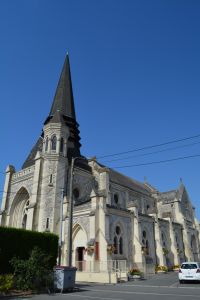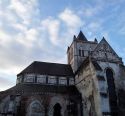Church | 1925 | Neoromanesque | Catholic Church




Map
Opening hours
01 January - 31 December
Mon 9.00 - 18.00
Tue 9.00 - 18.00
Wed 9.00 - 18.00
Thu 9.00 - 18.00
Fri 9.00 - 18.00
Sat 9.00 - 18.00
Sun 9.00 - 18.00
Religious offices
The church in Richebourg will welcome the team from ‘Le Jour du Seigneur’ for a broadcast of Mass on 16 November 2025 at 11 a.m.
Description
A church to be discovered when visiting the sites that commemorate the First World War, wih a Portuguese and an Indian cemetery visible at the entrance of the village, and an unusual war memorial in front of the church, representing a French soldier lying across a cenataph.
The church of St. Lawrence is one mong the 250 churches that were rebuilt after the destructions of the Great War. It replaces a 16th century building, which succeeded a 12thcentury romanesque building whose origines went back to the 6th century, period of the evangelisation of Artois by St. Vedast.
Built between 1918 and 1925, in lighht irregular stone blocks, the church is monumental in dimension and high with the proportions of its neo-romane
Nave and neo-gothic sanctuary. The interior contains rich liturgical furnishings : confessionals with particularly fine sculptures, a 16th century baptismal font of granite, a stoup , and the history of the church presented in the narthex.
Photos
Remarkable elements
Stoup
Like the baptismal font and the Christ in the Bindings, this font dates back to the enlargement of the church in the 16th century. Here too, it is the reuse of an old sandstone capital, the octagonal base of which is now used as a font. The date 1502 engraved on it appears to be apocryphal.
Translated with www.DeepL.com/Translator (free version)
Baptismal font
Dating from the 16th century, they are made of sandstone, but were damaged during the Great War and have since been covered with sprayed cement. The octagonal bowl rests on an upturned capital.
Translated with www.DeepL.com/Translator (free version)
Confessionals
A very fine example of carved oak in a neo-Gothic style that blends in with the architectural ensemble. These two confessionals, decorated with foliage, have doors lined with two saints. In the south aisle, the figures are Saint Peter, recognisable by his keys, and a cardinal holding the martyr's palm. In the north aisle, it is probably Mary Magdalene holding a skull and cross, accompanied by a holy bishop.
Translated with www.DeepL.com/Translator (free version)
Christ Bound
This 17th-century representation, very common in northern countries and in our region from the 15th century onwards, is one of the few items to have survived the destruction of the old church. Usually placed between Stations 10 and 11 of the Stations of the Cross, the Christ of Pity depicts the suffering and resignation of Christ as he awaits his execution.
Translated with www.DeepL.com/Translator (free version)
Stained glass windows
The light-filled church of Richebourg is enhanced by its 22 historiated stained glass windows by master glassworker Emile Janiaud. The windows in the nave date from 1935-36, while those in the choir and side chapels date from after 1945. These windows depict various scenes from the life of Christ, as well as different saints such as Joan of Arc and Saint Bernadette.
Translated with www.DeepL.com/Translator (free version)


















